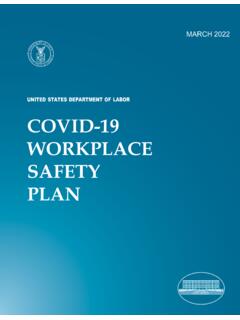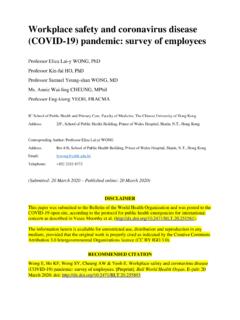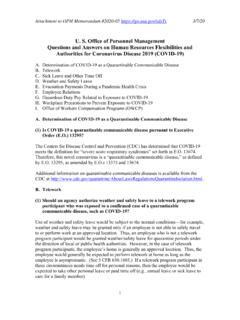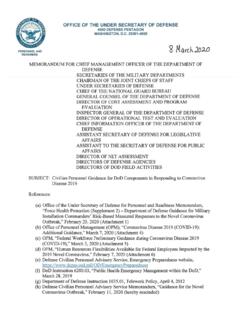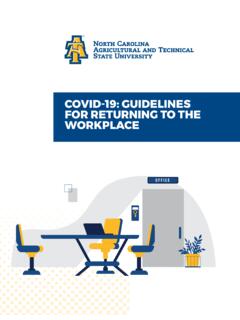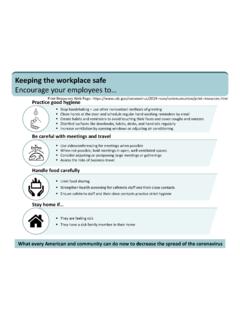Transcription of Respiratory Protection COVID-19 Compliance
1 Understanding Compliance with OSHA s Respiratory Protection Standard During the coronavirus disease 2019 ( COVID-19 ) Pandemic The coronavirus disease 2019 ( COVID-19 ) pandemic has had an unprecedented impact on the availability of respirators and fit-testing supplies. This document is intended to help employers understand and comply with OSHA s temporary enforcement guidance for the Respiratory Protection standard (29 CFR ). Background The COVID-19 pandemic has resulted in a public health emergency that has dramatically increased demand for respirators, particularly N-95 filtering facepiece respirators (FFRs), as well as fit-testing supplies ordinarily used to ensure that respirators fit workers properly and provide the expected level of Protection . Shortages (either intermittent or extended) of both FFRs and fit-testing supplies have posed tremendous challenges.
2 In order to allow essential operations to continue, many employers have had to utilize contingency and crisis strategies that are ordinarily not compliant with OSHA s Respiratory Protection standard. Examples of contingency and crisis strategies include: extended use of disposable FFRs, decontamination and reuse of disposable FFRs, and the use of foreign FFRs not approved by the National Institute for Occupational Safety and Health (NIOSH). It is important for employers to understand that deviations from normal respirator use come with increased risk for workers that, in certain circumstances, may only be allowable during this public health emergency because the alternative of no Respiratory Protection presents a greater danger to workers. In order to ensure adequate Protection for workers during the use of contingency and crisis strategies, OSHA has issued temporary enforcement guidance to its Compliance Safety and Health Officers (CSHOs).
3 This guidance allows CSHOs to exercise enforcement discretion in cases involving workplace exposures and an employer that is unable to comply with certain provisions of the Respiratory Protection standard because of supply shortages and has thus found it necessary to implement contingency or crisis strategies for respirator use by workers. Understanding OSHA s Temporary Enforcement Guidance In response to FFR and fit-testing supply shortages during the COVID-19 pandemic, OSHA has issued several temporary enforcement guidance memoranda allowing CSHOs to exercise enforcement discretion when Photo: CDC/NIOSH Given the evolving nature of the pandemic, OSHA is in the process of reviewing and updating this document. These materials may no longer represent current OSHA recommendations and guidance. For the most up-to-date information, consult Protecting Workers issuing citations under the Respiratory Protection standard and/or the equivalent Respiratory Protection provisions of other health standards.
4 CSHO enforcement discretion is applied only when circumstances beyond the employer s control prevent Compliance with certain parts of the Respiratory Protection standard and the employer makes objectively reasonable efforts to obtain and conserve supplies. Employers are also expected to explore options and modify practices to assure the best available Protection for workers ( , avoid the use of non-compliant Respiratory Protection when performing high hazard aerosol-generating procedures). Employers are expected to come into full Compliance with the Respiratory Protection standard once supply chain issues are resolved ( , conduct fit-testing once fit-testing supplies become available). OSHA will revoke all of the temporary enforcement discretions and revert to the normal enforcement of the Respiratory Protection standard once the Agency determines that the additional enforcement discretion is no longer necessary.
5 Employers Seeking Relief Under Temporary Enforcement Guidance It is important for employers to understand that these temporary enforcement guidance memoranda do not offer blanket waivers or exemptions for complying with any OSHA standards or provisions of such standards, including the Respiratory Protection standard ( , annual fit-testing requirements). Rather, they allow for enforcement discretion by CSHOs during the COVID-19 pandemic period only in circumstances where an employer can demonstrate that it made unsuccessful but objectively reasonable efforts to obtain and conserve supplies of FFRs and fit-testing supplies as outlined in the memoranda. Employers should understand that non- Compliance still violates the standard. However, these temporary enforcement guidance memos provide CSHOs discretion, on a case-by-case basis during the COVID-19 pandemic period only, to refrain from issuing citations to employers for violating certain provisions of the Respiratory Protection standard and/or the equivalent Respiratory Protection provisions of other health standards, where Compliance with these provisions is affected by supply shortages.
6 Each temporary enforcement guidance memorandum has specific criteria that CSHOs will assess during an inspection. For example, CSHOs will look for and consider documentation and other available information showing that the employer: Utilized strategies to prioritize and conserve the use of N95s according to CDC guidance: o Considerations for Release of Stockpiled N95s Beyond the Manufacturer-Designated Shelf Life o Strategies for Optimizing the Supply of N95 Respirators; Maintained a fully compliant Respiratory Protection Program (RPP) in all other regards ( , a written program that covers, among other required elements, procedures for medical evaluation of employees, respirator maintenance and care, employee training); Reassessed their engineering and administrative controls, and work practices, and identified and implemented changes to decrease the need for N95s without exposing employees to additional hazards ( , considering whether it is possible to temporarily suspend certain procedures, such as high hazard elective medical procedures, or to increase the use of other feasible protections, such as moving operations outdoors, using job rotation schedules, or improving the use of wet methods or portable local exhaust systems when performing dust-generating tasks); Monitored respirator supplies and made objectively reasonable efforts to obtain NIOSH-approved respirators; and, in healthcare settings, prioritized the best Respiratory Protection options available for use during high hazard aerosol-generating medical procedures.
7 Explored options to obtain and use other types of respirators ( , P-100s, non-disposable, elastomeric respirators, and powered air-purifying respirators (PAPRs), as well as foreign respirators that are not NIOSH-approved) that offer equivalent or higher Protection when N-95s were not available; and Monitored fit-testing supplies and made objectively reasonable efforts to obtain fit-testing supplies. If employers can demonstrate objectively reasonable efforts to comply with the Respiratory Protection standard, and/or the equivalent Respiratory Protection provisions of other health standards, then OSHA may exercise enforcement discretion in accordance with the memoranda during the COVID-19 pandemic.










